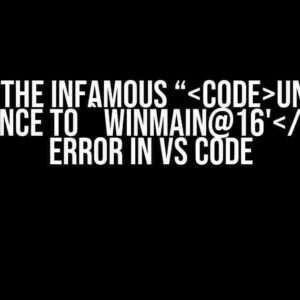Initializing objects on the stack or heap is a fundamental concept in programming, and it’s essential to understand the proper way to do it to avoid common pitfalls and memory-related issues. In this article, we’ll dive into the world of object initialization and explore the best practices for initializing objects on the stack and heap.
Understanding the Stack and Heap
Before we dive into the proper way to initialize objects, let’s briefly review the stack and heap.
The stack is a region of memory that stores data temporarily while a program is executing. It’s a Last-In-First-Out (LIFO) data structure, meaning that the last item added to the stack is the first one to be removed. The stack is used to store function call stack frames, local variables, and other temporary data.
The heap, on the other hand, is a region of memory that stores data that persists beyond the lifetime of a single function call. It’s a global memory pool that’s used to store objects and data structures that need to be accessed globally.
Initializing Objects on the Stack
Initializing objects on the stack is a straightforward process. When you declare a variable or an object on the stack, the compiler automatically allocates the necessary memory and initializes the object.
Example:
class MyClass {
public:
MyClass() {
cout << "MyClass constructor called!" << endl;
}
};
int main() {
MyClass obj;
return 0;
}
In this example, when we declare the `obj` object, the compiler automatically calls the `MyClass` constructor, which initializes the object on the stack.
Here are some best practices to keep in mind when initializing objects on the stack:
- Use automatic storage duration variables: As shown in the example above, using automatic storage duration variables (i.e., declaring variables inside a function or block) ensures that the object is destroyed when it goes out of scope, preventing memory leaks.
- Avoid using raw pointers: Raw pointers can lead to memory leaks and dangling pointers. Instead, use smart pointers or references to manage object lifetimes.
- Use constructor initialization: Use constructor initialization to initialize objects on the stack. This ensures that the object is properly initialized and avoids default initialization.
Initializing Objects on the Heap
Initializing objects on the heap is a bit more complex than initializing objects on the stack. When you allocate memory on the heap, you need to manually manage the object's lifetime using pointers.
Example:
class MyClass {
public:
MyClass() {
cout << "MyClass constructor called!" << endl;
}
};
int main() {
MyClass* ptr = new MyClass();
// Use the object
delete ptr;
return 0;
}
In this example, we use the `new` operator to allocate memory on the heap and create an instance of `MyClass`. We then use the `delete` operator to manually manage the object's lifetime and prevent memory leaks.
Here are some best practices to keep in mind when initializing objects on the heap:
- Use smart pointers: Smart pointers like `unique_ptr` and `shared_ptr` can help manage object lifetimes and prevent memory leaks.
- Avoid naked pointers: Naked pointers (i.e., raw pointers) can lead to memory leaks and dangling pointers. Use smart pointers or references instead.
- Use RAII (Resource Acquisition Is Initialization): RAII is a technique that uses an object's lifetime to manage resources like memory. This ensures that resources are released when the object goes out of scope.
When to Use the Stack and When to Use the Heap
So, when should you use the stack, and when should you use the heap? Here are some general guidelines:
| Criteria | Stack | Heap |
|---|---|---|
| Object lifetime | Short-lived, scope-based | Long-lived, global scope |
| Memory allocation | Automatic, managed by compiler | Manual, managed by programmer |
| Performance | Faster, more efficient | Slower, more overhead |
| Memory safety | Less prone to memory leaks | More prone to memory leaks |
In general, use the stack for short-lived objects with automatic storage duration, and use the heap for long-lived objects with manual memory management.
Conclusion
In conclusion, initializing objects on the stack or heap requires careful consideration of object lifetimes, memory management, and performance. By following best practices and understanding the differences between the stack and heap, you can write more efficient, safe, and scalable code.
Remember to use automatic storage duration variables on the stack, and smart pointers and RAII on the heap. Avoid naked pointers and manual memory management whenever possible, and always consider the object's lifetime and memory safety when deciding whether to use the stack or heap.
By mastering the art of object initialization, you'll be well on your way to writing robust, reliable, and maintainable code that's free from memory-related issues.
So, what's the proper way to initialize objects on the stack or heap? The answer is simple: use the stack for short-lived objects with automatic storage duration, and use the heap for long-lived objects with manual memory management. And always, always follow best practices to ensure memory safety and performance.
Frequently Asked Question
Initializing objects on the stack or heap can be a bit tricky, but fear not, dear coder! We've got the scoop on how to do it properly.
What's the main difference between initializing objects on the stack and on the heap?
When you initialize an object on the stack, it's stored in the memory allocated for the current function call. It gets destroyed when the function returns. On the other hand, objects on the heap are stored in the dynamic memory, and they persist until you manually delete them or the program ends.
How do I initialize an object on the stack in C++?
In C++, you can initialize an object on the stack using the default constructor or by assigning a value to it. For example: `MyClass obj;` or `MyClass obj = MyClass();`. This way, the object will be created on the stack and destroyed when it goes out of scope.
How do I initialize an object on the heap in C++?
In C++, you can initialize an object on the heap using the `new` keyword. For example: `MyClass* obj = new MyClass();`. This way, the object will be created on the heap, and you'll need to manually delete it when you're done with it using `delete obj;`.
What are the pros and cons of initializing objects on the stack versus on the heap?
Initializing objects on the stack is generally faster and more efficient, since it doesn't involve dynamic memory allocation. However, it also means the object will be destroyed when it goes out of scope. Initializing objects on the heap provides more flexibility, but it can lead to memory leaks if not handled properly.
Are there any best practices to keep in mind when initializing objects on the stack or heap?
Yes! When initializing objects on the stack, make sure to keep an eye on scope and lifetime. When initializing objects on the heap, use smart pointers or containers to manage memory automatically. And always follow the Rule of Five: if you need to implement a destructor, copy constructor, or copy assignment operator, you probably need to implement all five.




